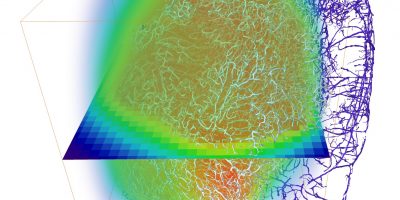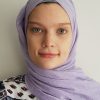Academic Background
Georgina received a first-class honours Master of Science (MSci) degree from UCL in 2017, completing modules including fluid mechanics, mathematical biology, and statistical physics.
During her degree she undertook two summer projects, receiving the EPSRC Summer Vacation Bursary in consecutive years, in the area of mathematical modelling applied to tissue engineering. The first project concerned the cell environment in a collagen construct in vivo, designing and conducting experiments in cell culture in order to obtain necessary model parameters. In the second project, Georgina constructed a multiphase model of the aggregation of cells in a hydrogel to investigate the process of vascularisation, to ultimately optimise variable parameters for in vitro vascularisation of a tissue-engineered construct.
Her fourth year project with Professor Karen Page and Dr James Briscoe involved using Python to model the cell fates of neuromesodermal stem cells, based on a simplified gene circuit in the presence of dynamic morphogen levels. Several cases of morphogen upregulation, the effect of noisy initial conditions, and the impact of relative morphogen diffusion speeds were investigated to demonstrate the robustness and distribution of the cell fates, to compare to relevant in vitro work undertaken at the Francis Crick Institute.
Georgina began her PhD in 2017 under the supervision of Dr Nick Ovenden, Dr Rebecca Shipley, and Dr James Phillips, and will be working on a mathematical model of vasculogenesis in vitro to inform the development of a pre-vascularised tissue engineered construct.
Georgina is funded by EPSRC via the National Productivity Investment Fund (NPIF).
Qualifications
MSci (Hons) Mathematics and Physics, University College London (2017)
Conference Proceedings
G Kennedy, RH Coy, C Kayal, C O’Rourke, PJ Kingham, RJ Shipley, JB Phillips. In vitro experiments to inform cell seeding strategies and parameterize a mathematical model for peripheral nerve repair (Presentation, Tissue and Cell Engineering Society Annual Meeting 2016, UCL). European Cells and Materials Vol. 32. Suppl. 4, 2016 (page 21).
RH Coy, G Kennedy, C Kayal, C O’Rourke, PJ Kingham, JB Phillips, RJ Shipley. A mathematical model informed by in vitro experiments to advance engineered nerve repair construct design (Presentation, TCES 2016). European Cells and Materials Vol. 32. Suppl. 4, 2016 (page 36).
RH Coy, G Kennedy, C Kayal, P Kingham, JB Phillips, RJ Shipley. A joint theoretical – experimental approach to investigate the effects of low oxygen environments upon therapeutic cell viability and VEGF production (Presentation, Tissue Engineering and Regenerative Medicine International Society EU Meeting 2016, Uppsala, Sweden.). European Cells and Materials Vol. 31. Suppl. 1, 2016 (page 174).
RJ Shipley, RH Coy, T Evans, OR Evans, G Kennedy, D Hodgson, JB Phillips. Mathematical models as a tool to direct the spatial distribution of cells and materials in tissue-engineering conduits for peripheral nerve repair (Poster, TCES 2015). European Cells and Materials Vol. 29. Suppl. 3, 2015 (page 98).

 Close
Close


